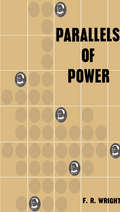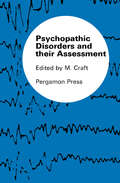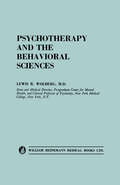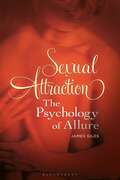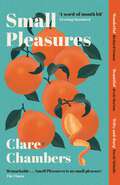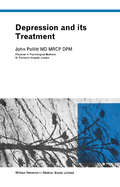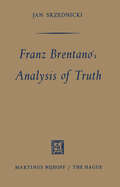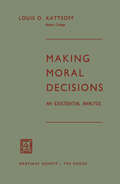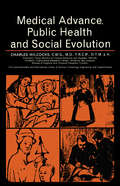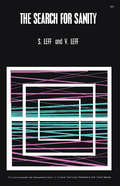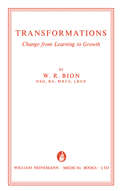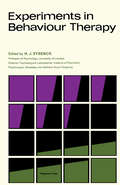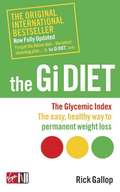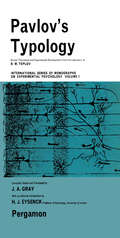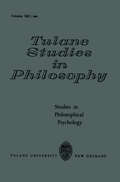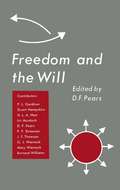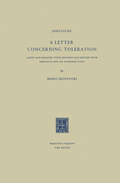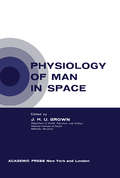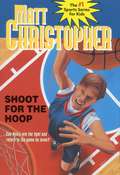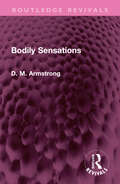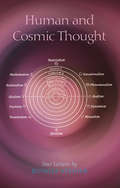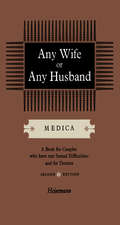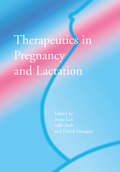- Table View
- List View
Parallels of Power: An Introduction to Some Individualists of Church and State
by F. Richard WrightParallels of Power: An Introduction to Some Individualists of Church and State is a 21-chapter text that covers the leading persons in Church and State in their respective periods of history. In the early days of the Church the Christian fathers worked inside the framework of the Roman Empire and used its organization as the basis for the spreading Christian churches. By the 17th century then, the relations between Church and State had turned full circle, from the early days of struggle between them for supremacy, the Church had become the main support of the National State. Each chapter discusses the life story, influence, and the struggles of the leading religious figures, both in Church and State. Professional historians will find this book rewarding.
Psychopathic Disorders and Their Assessment
by Michael CraftPsychopathic Disorders and their Assessment considers the diverse views and significant developments in understanding psychopathic disorders. This book is composed of 12 chapters, and begins with a description of the primary and negative features of the condition. The subsequent chapters are concerned with the methods of disposal of a psychopath under English law, the safeguards available both to the individual and to society within and without the Mental Health Act, and the extent to which this disposal mechanism was used. These topics are followed by discussions on the causation of psychopathic disorder; the electroencephalographic and psychological techniques for the disorder evaluation; and various methods of patient care. The last chapters consider the law and practice relating to psychopathic disorder and British facilities for the treatment of psychopaths. This book is of value to psychologists and psychiatrists.
Psychotherapy and the Behavioral Sciences: Contributions of the Biological, Psychological, Social and Philosophic Fields to Psychotherapeutic Theory and Process
by Lewis R. WolbergPsychotherapy and the Behavioral Sciences discusses the techniques used in neurophysiological analysis. It defines the neuronal building blocks. The book provides a detailed examination of the brain. This is followed by a discussion of the function of cerebral cortex. A chapter of the text focuses on biochemical interactions including neuropharmacology and psychopharmacology. The volume defines such terms as genetics, behavior genetics, and ethology. This is followed by a discussion on the conditioning of neural circuits. Another chapter is devoted on the examination of stress and adaptation. Ontogenetic maturation, developmental, and personality theories are explored analytically. The development of personality is the focus of fourth chapter. Concepts such as learning theory, learning principles, and psychoanalytic theory are fully explained. Cultural anthropology is the subject of the tenth chapter. While cybernetics is discuss in the eleventh chapter of the book. The book will provide useful information to psychologists, psychoanalysts, students, and researchers in the field of psychology.
Sexual Attraction: The Psychology of Allure
by James GilesHow and why does sexual attraction happen? This book is an exploration of the universal yet highly individualized experience of being sexually attracted to another person.Incorporating interviews, research findings, and excerpts from romantic and erotic literature, lyrics, and film, Sexual Attraction: The Psychology of Allure explores a subject that is central to the human experience and highly relevant not only in personal, intimate interactions but also other relationships as well. Although the causes and effects of sexual attraction have been studied, sexual attraction itself—how we experience others in terms of their sexual attractiveness—remains a neglected, rarely researched topic.Scholar James Giles presents jargon-free information that is accessible and fascinating to the general reader as well as highly useful and informative to students and researchers in social psychology, sexology, sex and marital therapy, and relationship counseling. The book explores subjects such as how sexual attraction is fundamentally different from other forms of interpersonal attraction and how at the heart of sexual attraction lies the experience of allure—something that makes one feel helplessly drawn towards an intimate physical joining with the sexually attractive person. The allure of strangers, cross-sex friends, sexual friends ("friends with benefits"), and romantic partners are all addressed, revealing the often subtle heterosexual attraction that typically exists between males and females in all their relationships, including between those who are ostensibly "just friends."
Small Pleasures: Longlisted for the Women's Prize for Fiction
by Clare ChambersLONGLISTED FOR THE WOMEN'S PRIZE FOR FICTION 2021'A WORD-OF-MOUTH HIT' Evening Standard 'A very fine book... It's witty and sharp and reads like something by Barbara Pym or Anita Brookner, without ever feeling like a pastiche'David Nicholls'Perfect'India Knight 'Beautiful' Jessie Burton'Wonderful'Richard Osman 'Miraculous'Tracy Chevalier 'A wonderful novel. I loved it'Nina Stibbe 'Effortless to read, but every sentence lingers in the mind' Lissa Evans 'This is one of the most beautiful books I have ever read. I honestly don't want you to be without it'Lucy Mangan'Gorgeous... If you're looking for something escapist and bittersweet, I could not recommend more' Pandora Sykes'Remarkable... Small Pleasures is no small pleasure'The Times'An irresistible novel - wry, perceptive and quietly devastating'Mail on Sunday'Chambers' eye for undemonstrative details achieves a Larkin-esque lucidity' Guardian'An almost flawlessly written tale of genuine, grown-up romantic anguish' The Sunday Times 1957, the suburbs of South East London. Jean Swinney is a journalist on a local paper, trapped in a life of duty and disappointment from which there is no likelihood of escape. When a young woman, Gretchen Tilbury, contacts the paper to claim that her daughter is the result of a virgin birth, it is down to Jean to discover whether she is a miracle or a fraud. As the investigation turns her quiet life inside out, Jean is suddenly given an unexpected chance at friendship, love and - possibly - happiness. But there will, inevitably, be a price to pay.Book of the Year for: The Times, Daily Telegraph, Evening Standard, Daily Express, Metro, Spectator, Red Magazine and Good Housekeeping
Depression and Its Treatment
by John PollittDepression and its Treatment focuses on medical interventions in the diagnosis and treatment of depression, as well as identification of symptoms and possible mechanisms of treatment. The book first offers information on the concept and classification of depression, physiology and psychopathology, and clinical types of depression, including classification of depressive illnesses and etiology. The publication then takes a look at the treatment of psychological and physiological depression and complications of depression and their treatment. The text ponders on the prognosis of psychological and physiological depression and critique of existing terminology, as well as illustrative case histories of depression. The manuscript is highly recommended for clinicians and psychiatrists wanting to explore the approaches in the treatment of depression.
Franz Brentano’s Analysis of Truth
by Jan SrzednickiFranz Brentano 1 was an important philosopher, but for a long time his importance was under-estimated. At least in the English speaking countries, he came to be remembered best as the initiator of a philoso phical position which he in fact abandoned for good and sufficient 2 reasons. His ultimate and most important contributions passed almost unnoticed. Even such a well-informed and well-prepared book as Passmore's IOO Years 01 Philosophy (Duckworth, 1957), is open to the same comment; Passmore concentrated his attention on the early Brentano, because he regarded his influence on the British philo sophical scene as being confined to Brentano's early work. Brentano's pupils, e. g. , Husserl, Meinong, Marty and Twardowski, were often influential and, often enough, they departed from the strict common sense and advisedly cautious attitude of their great teacher. Thus even on the continent, the public image of Brentano tended to be incomplete (and sometimes distorted), outside the narrower circle of pupils, followers, and people with special interest. This, or very nearly this, was still the case in 1955, when my contacts with the followers of Twardowski made me turn towards the study of Brentano. Since then there has been a gratifying revival of interest in his work. His early book on Aristotle was reprinted in German and two of his main positions, Psychologie and Wahrheit und Evidenz, are appearing in English translations. Translations into other languages, e. g.
Medical Advance, Public Health and Social Evolution: The Commonwealth and International Library: Liberal Studies Division
by Charles WilcocksMedical Advance, Public Health and Social Evolution is an attempt to relate medical progress to the intellectual climate of the various broad periods of history, and to the social changes which took place in those periods and which influenced—and were influenced by—medical progress. Since the intellectual developments and historical events which have impinged upon medical progress have occurred in the setting of history, it has therefore been convenient to divide the book into chapters with a historical basis. The book begins with discussions of Greek and Roman life and medicine; Indian and Persian life and medicine; the Middle Ages; and the Renaissance and the resuscitation of science; and the sixteenth, seventeenth, and eighteenth centuries. Separate chapters then deal with the development of hygiene; the bacteriological era; bacteriological control of food and water; and disease transmission by arthropods. Subsequent chapters cover drugs, antibiotics, hormones, and anesthetics; occupational medicine; degenerative diseases, cancer, radiology, and medical genetics; psychological medicine; and statistical methods and experiments on man and animals.
Psychosomatic Disorders in Adolescents and Young Adults: Proceedings of a Conference Held by the Society for Psychosomatic Research at the Royal College of Physicians, London. November 1960
by John Hambling Philip HopkinsPsychosomatic Disorders in Adolescents and Young Adults covers the proceedings of the 1960 Conference, held by the Society for Psychosomatic Research at the Royal College of Physicians, London. This conference considers psychosomatic disorders occurring between the ages of 15-25 years and discusses the mental transformation from childhood to adult maturity. This book is organized into eight sessions encompassing 26 chapters. The first two sessions review the concepts of mental health and the psychosexual development in adolescence. The next sessions looks into the issues of teenage pregnancy, menstrual disorders, emotional sweating, male sexual disorders, epilepsy in adolescence, and psychosomatic aspects of acne vulgaris. These topics are followed by discussions on stress-related disorders, including tuberculosis and acute appendicitis. The remaining sessions describe certain aspects of mental transformation, such as the link between family and emotional maturity and fitness for marriage.
The Search for Sanity: The Commonwealth and International Library
by S. Leff V. LeffThe Search for Sanity provides a comprehensive discussion of the issue of mental illness. The book begins by addressing the question of whether society is sick. This is followed by separate chapters on the social aspects of mental health; the problems caused by sex such as prostitution, sexually transmitted disease, and illegitimate births; how the quest for power can destroy people; and ways people try to escape from reality, including drug use and alcohol consumption. Subsequent chapters cover the treatment for mental illness, how treatment helps, hospital care, and ways the community can help. The final chapter deals with the promotion of mental health and prevention of mental illness.
Transformations: Change from Learning to Growth
by W. R. BionTransformations: Change from Learning to Growth is a 12-chapter text that explores the fundamentals and principles of psycho-analytic theories, transformations, and invariants. This book begins with a clinical illustration of the distinction between the patient’s experience and the psycho-analyst’s experience. The succeeding chapters cover the influence of verbal expression, emotional experience, state of mind, and consciousness in psycho-analysis and transformation. These topics are followed by discussion on the relationship of the “no-thing" and the thing, wherein the personality that is capable of tolerating a no-thing can make use of the no-thing, and so is able to make use of the so-called thoughts. The remaining chapters describe a clinical system that would represent the chief clinical systems that can be seen to exist in the analytic situation. These chapters also examine the gap between reality and the personality, which are aspects of life with which analysts are familiar under the guise of resistance. Resistance operates because it is feared that the reality of the object is imminent. This book will be of value to psycho-analysts, psychologists, and psychiatrists.
Experiments in Behaviour Therapy: Readings in Modern Methods of Treatment of Mental Disorders Derived from Learning Theory
by H. J. EysenckExperiments in Behavior Therapy: Readings in Modern Methods of Treatment of Mental Disorders Derived from Learning Theory focuses on experiments involving the application of modern theories of learning and conditioning to behavior disorders.The selection first offers information on the nature of behavior and systematic desensitization treatment of neuroses. Discussions focus on the technique of systematic desensitization, examples of hierarchies from actual cases, and desensitization procedure. The text then ponders on experimental desensitization of a phobia, treatment by a method derived from experimental psychology, and treatment of anxiety and phobic reactions by systematic desensitization psychotherapy. The publication examines the treatment of chronic frigidity by systematic desensitization, application of reciprocal inhibition therapy to exhibitionism, and group therapy of phobic disorders by systematic desensitization. The isolation of a conditioning procedure as the crucial psychotherapeutic factor; application of learning principles to the treatment of obsessive-compulsive states in the acute and chronic phases of illness; and case of homosexuality treated by aversion therapy are also discussed. The selection is a dependable source of data for readers interested in behavior therapy.
The Gi Diet (Now Fully Updated): The Glycemic Index; The Easy, Healthy Way to Permanent Weight Loss
by Rick GallopThe Original International Gi Diet Bestseller, Now Revised And Updated- Over 40 all new recipes and meal plans- Over 100 new red, yellow and green light food listings- Updates on everything from low carbs to office lunches and family meals- More readers' comments and suggestionsMost diets fail for these three reasons - you go hungry, they're too complicated or they are simply unhealthy. With Rick Gallop's acclaimed Gi diet- you won't feel hungry or deprived- you will never have to count calories, carbs or points again- it's healthy and nutritious and will reduce your risk of major diseases.Based on the Glycemic Index, or GI, which rates foods according to how fast they are digested, the Gi Diet makes choosing the right food simple with its unique, easy-to-follow traffic light system:*Foods to avoid*Foods to eat occasionally*Foods to eat as much of as you wantAnd the benefits are more than just weight loss! Changing your eating habits can also help prevent life-threatening illnesses, like heart disease and diabetes."Losing weight is relatively easy with many "fad" Diets; maintaining the loss with these diets is difficult and largely impossible to sustain. Rick Gallop has found the key to permanent weight loss"
Pavlov's Typology: Recent Theoretical and Experimental Developments from the Laboratory of B. M. Teplov Institute of Psychology, Moscow
by H. J. Eysenck J. A. GrayInternational Series of Monographs on Experimental Psychology, Volume 1: Pavlov's Typology presents problems of personality and the theoretical framework done in the U.S.S.R. Part 1 of this book deals with the development of Pavlov's theory of personality on experiments conducted on dogs and the problems encountered in studies of higher nervous activity in man and animals. These tests include investigation into the capacity of cortical cells of the test subject; the speed of movement and termination of the nervous process; and the speed of formation of positive and negative conditioned connections. Part 2 is the application of Pavlov's theory of types to individual differences in human beings. This part emphasizes that when using data from Pavlov's studies of animals, typological differences are considered when applied in man; that experimental methods are to be improved; and that operations definitions and concepts can change. Part 3 concerns experiments from Teplov's laboratory on the dimension of strength of the nervous systems in human beings. This strength is shown from the working capacity of nerve cells as 1) the strength of excitation the nerve-cell can endure when a stimulus acts on it in a single time and 2) the time that the nerve-cell can endure prolonged stimulus or at shorter but frequent intervals. The conclusions observed in strong subjects and weak subjects are then analyzed. This book can be appreciated by psychiatrists, psychologists, behavioral scientists, and students and professors in psychology.
Studies in Philosophical Psychology (Tulane Studies in Philosophy #13)
by James K. Feibleman Harold N. Lee Donald S. Lee Shannon Du Bose Edward G. Ballard Robert C. Whittemore Andrew J. ReckA Letter Concerning Toleration: Latin and English Texts Revised and Edited with Variants and an Introduction
by John LockeLimborch's edition and Popple's translation, as on whether it is true that Popple translated the Epistola into English 'a l'insu de Mr Locke', and consequently whether Locke was right or wrong in saying that the translation was made 'without my privity'. Long research into documents hitherto unpublished, or little known, or badly used, has persuaded me that Locke not only knew that Popple had undertaken to translate the Gouda Latin text, but also that Locke followed Popple's work very closely, and even that the second English edition of 1690 was edited by Locke himself. In these circumstances it does not seem possible to speak of an original text, that in Latin, and an English translation; rather they are two different versions of Locke's thoughts on Toleration. The accusations of unreliability levelled at Popple therefore fall to the ground, and the Latin and English texts acquire equal rights to our trust, since they both deserve the same place among Locke's works. Consequently the expression 'without my privity', which a number of people had seen as revealing an innate weakness in Locke's moral character, reacquires its precise meaning: testifying to Locke's profound modesty and integrity.
Physiology of Man in Space
by J. H. U. BrownPhysiology of Man in Space describes the physiological responses of man under the extremes of space flight. This book is composed of eight chapters that specifically examine the physiological responses of astronaut under zero gravity conditions. The introductory chapter demonstrates how human neuromuscular system can withstand the stresses of short-term space travel. The succeeding chapters describe human responses under space acceleration stress. These topics are followed by discussions on human stress tolerance capacity; psychological aspects of space flight; instrumentation in biomedical capsules in space flight; and the phenomenon of space weightlessness. The final chapter deals with the impact of the environment on the man and the impact that the man has on the environment, including environmental, metabolic, and waste removal parameters. This book is of value to space scientists and researchers.
Shoot for the Hoop
by Matt ChristopherWhen Rusty Young is diagnosed with diabetes, his parents want him to stop playing basketball, but Rusty doesn't want to. When Rusty learns that his friends have formed a summer league team, he is determined to persuade his parents to let him join them.
Bodily Sensations (Routledge Revivals)
by D M ArmstrongFirst published in 1962, Bodily Sensations argues that bodily sensations are nothing but impressions that physical happenings are taking place in the body, impressions that may correspond or fail to correspond to physical reality. In the case of such sensations as pains, these impressions are accompanied by certain attitudes to the impressions. He argues, that is to say that bodily sensations are a sub-species of sense-impression, standing to perception of our own bodily state (or in some cases to touch) as visual impressions stand to the sense of sight. He examines, and tries to refute, all plausible alternative accounts of the nature of bodily sensations. He prefaces his argument by an account of tactual and bodily perception. Here he argues that, with the exception of heat and cold, the qualities discerned by these senses are all reducible to spatial and temporal properties of material objects. Combined with his own conclusions on bodily sensations, this allows him to draw up a short and exhaustive list of the so-called "secondary" qualities of physical objects. This book will be of interest to students of philosophy.
Bodily Sensations (Routledge Revivals)
by D M ArmstrongFirst published in 1962, Bodily Sensations argues that bodily sensations are nothing but impressions that physical happenings are taking place in the body, impressions that may correspond or fail to correspond to physical reality. In the case of such sensations as pains, these impressions are accompanied by certain attitudes to the impressions. He argues, that is to say that bodily sensations are a sub-species of sense-impression, standing to perception of our own bodily state (or in some cases to touch) as visual impressions stand to the sense of sight. He examines, and tries to refute, all plausible alternative accounts of the nature of bodily sensations. He prefaces his argument by an account of tactual and bodily perception. Here he argues that, with the exception of heat and cold, the qualities discerned by these senses are all reducible to spatial and temporal properties of material objects. Combined with his own conclusions on bodily sensations, this allows him to draw up a short and exhaustive list of the so-called "secondary" qualities of physical objects. This book will be of interest to students of philosophy.
Human and Cosmic Thought
by Rudolf SteinerRudolf Steiner demonstrates that there are twelve main philosophical standpoints, and that the future of philosophy rests not upon defending one and refuting the others, but in learning to experience the validity of them all.What convinces us of the truth of a certain point of view? Why do we find it difficult to comprehend viewpoints that differ from our own? What are the inner foundations of our knowledge? In these concentrated and aphoristic lectures, Steiner speaks of twelve main philosophical standpoints, and the importance of understanding each of them. An appreciation of the variety of possible world views not only sharpens and makes more flexible our own powers of thinking, but helps us to overcome a narrow-minded one-sidedness, promoting tolerance of other people and their opinions.Steiner goes on to explain how each standpoint is also coloured by a particular ‘soul mood’, which influences the way we actively pursue knowledge. Several philosophers and their works are characterised in this manner, throwing light on their contributions to human culture. Through such insight into the true nature of human thinking, we are led to understand the quality of cosmic thought and how, in Rudolf Steiner’s words, the human being can be seen as a ‘thought which is thought by the Hierarchies of the cosmos’.
Any Wife or Any Husband: A Book for Couples Who Have Met Sexual Difficulties and for Doctors
by Joan GrahamAny Wife or Any Husband: A Book for Couples Who Have Met Sexual Difficulties and for Doctors, Second Edition covers both the physical and emotional factors of marital disorders. The book describes sexual problems and theoretical considerations and the range of sexual capacity of an individual. The text then discusses common disorders in women (i.e. vaginal or clitoral anesthesia, orgasm inhibition, total genital anesthesia, and vaginismus) and in men (i.e. premature ejaculation, failure of erection, avoidance, and difficulty with ejaculation). Common sexual problems; deviations and adaptations; and treatments are also considered. Psychologists, couples who have experienced sexual difficulties, and doctors will find the book useful.
Therapeutics in Pregnancy and Lactation
by Anne Lee Sally Inch David FineganThis book will assist doctors, pharmacists, midwives and other health professionals in dealing with the issue of medicine use in pregnant and breastfeeding women. It gives practical guidance on the principles of safe and effective prescribing, summarises the known effects of widely used drugs, and provides up-to-date information in one accessible source. With an impressive list of contributors, Therapeutics in Pregnancy and Lactation offers clear guidelines and comprehensive advice on a diverse range of topics from drug abuse to hypertension and epilepsy.
